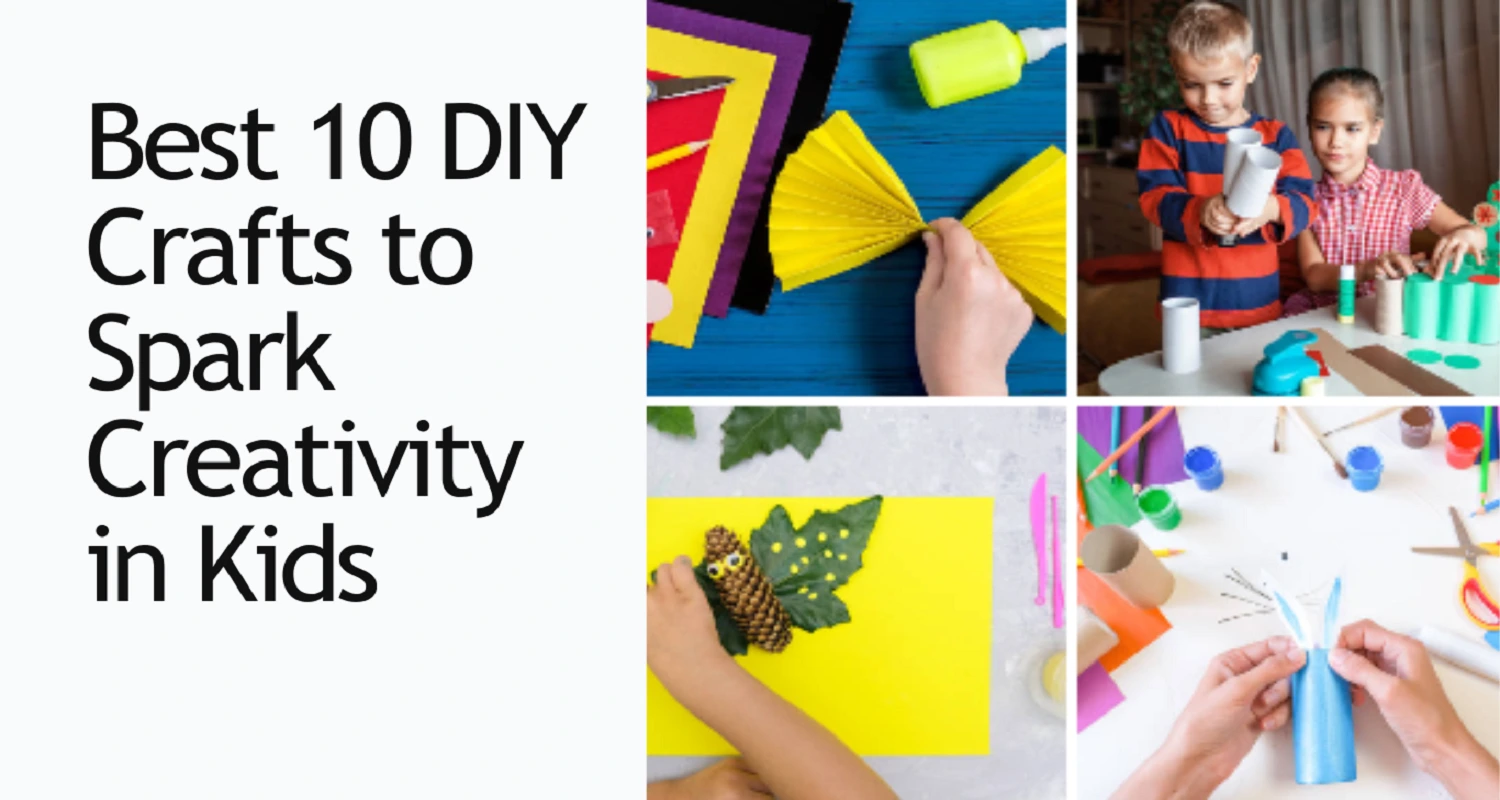Crafting with kids is a fantastic way to spend quality time while fostering creativity, problem-solving, and fine motor skills. Engaging in hands-on projects not only enhances a child’s development but also strengthens the parent-child bond. The best part? Many of these activities require only simple supplies you already have at home. Below the Best 10 DIY Crafts to Spark Creativity in Kids, fun, educational, and easy.
1. Paper Plate Animals
Paper plate animals are a classic craft that allows children to explore their creativity while learning about different animals. The simplicity of the project makes it accessible for children of all ages. Have your kids select an animal, then draw, cut, and glue features like ears, noses, and tails onto paper plates. This craft is an excellent way to teach about animals while improving fine motor skills as children manipulate the materials.
Supplies Needed:
- Paper plates
- Colored paper for features
- Glue, markers, crayons
2. Rainbow Pasta Necklaces
Creating colorful pasta necklaces is both an engaging and educational activity that teaches children about patterns and color theory. Begin by dying uncooked pasta in different colors using food coloring and vinegar. Once the pasta is dry, children can string the pasta onto yarn to create necklaces, bracelets, or garlands. This project encourages creativity, enhances hand-eye coordination, and introduces basic sequencing concepts.
Supplies Needed:
- Uncooked pasta (like penne or ziti)
- Food coloring and vinegar
- Yarn or string
3. Cardboard Tube Rockets
Turn simple cardboard tubes into vibrant rockets! Children can paint or decorate empty toilet paper rolls and add features like paper fins or a cone-shaped top to complete the look. This craft not only sparks their imagination but also introduces basic concepts of space exploration, including rocket shapes and functions.
Supplies Needed:
- Empty toilet paper rolls
- Paint, markers, or crayons
- Construction paper, glue
4. Salt Dough Ornaments
Salt dough is easy to make and versatile for crafting ornaments or keepsakes. Simply mix flour, salt, and water to create dough that can be shaped into various designs. After baking, kids can paint their creations, helping develop both creativity and patience. These salt dough ornaments can be personalized with handprints or holiday-themed shapes, making them great for gifting or as treasured mementos.
Supplies Needed:
- 1 cup of flour, 1/2 cup of salt, 1/2 cup of water
- Cookie cutters, rolling pin
- Paints, brushes
5. Tissue Paper Collages
Tissue paper collages provide endless opportunities for creative expression. Children can tear or cut tissue paper into shapes and layer them on a canvas to create vibrant, textural artwork. This activity introduces color theory and composition while allowing children to practice fine motor skills as they manipulate the tissue paper.
Supplies Needed:
- Tissue paper in various colors
- Glue sticks or liquid glue
- Thick paper or cardboard
6. Nature Art
Nature art encourages children to explore their surroundings and use natural materials in their creations. During a nature walk, collect leaves, flowers, and twigs, then use them to create unique artwork. Children can glue their findings onto paper or press them into clay to make textured prints. This craft instills an appreciation for nature and helps develop observational skills.
Supplies Needed:
- Leaves, twigs, flowers, or stones
- Paper, glue, clay (optional)
- Paint (optional for prints)
7. Handprint Art
Handprint art offers a fun, sensory experience that also creates lasting keepsakes. Dip your child’s hands in washable paint and press them onto paper or canvas to make a handprint. Then, transform the handprint into an animal, tree, or other creative designs using markers or more paint. The tactile element of this activity adds to its appeal for young children.
Supplies Needed:
- Washable paint
- Paper or canvas
- Markers or crayons for decorating
8. Paper Bag Puppets
Creating puppets from paper bags is an imaginative craft that doubles as a storytelling activity. Children can decorate the bags with markers, yarn, and paper cutouts to create their own unique characters. Afterward, they can put on a puppet show, encouraging imaginative play, language development, and social interaction.
Supplies Needed:
- Paper bags
- Markers, yarn, googly eyes, scissors, glue
- Additional materials for customization
9. Egg Carton Caterpillars
Transforming egg cartons into caterpillars is an eco-friendly way to create adorable creatures while teaching children about insects. Simply cut out a row of egg cups, paint them in bright colors, and attach googly eyes and pipe cleaner antennae. This simple project promotes fine motor development and creativity while offering a great opportunity to discuss the life cycle of a caterpillar.
Supplies Needed:
- Egg cartons
- Paints, brushes
- Pipe cleaners, googly eyes
10. Paper Roll Binoculars
Turn empty toilet paper rolls into pretend binoculars for outdoor adventures. Have children glue two rolls together, decorate them with markers or stickers, and add a string for wearing around the neck. This craft is perfect for encouraging imaginative play and getting kids excited about exploring their environment.
Supplies Needed:
- Two toilet paper rolls per child
- Paint, stickers, markers
- Yarn or string
Expanding Creativity with Everyday Supplies
What’s truly magical about crafting with kids is the simplicity of using everyday materials. Items like paper plates, cardboard tubes, and egg cartons are often found in the recycling bin, but they hold endless creative potential. Repurposing these materials teaches children the value of recycling and sustainability while enhancing their resourcefulness.
Each of the crafts listed above also promotes various developmental skills. For example, threading pasta in the necklace project helps fine-tune hand-eye coordination, while designing rockets or animals encourages critical thinking. By engaging in these activities, children also build problem-solving skills, gain confidence in their creativity, and learn to express themselves through art.
Incorporating Learning into Craft Time
Craft time can easily double as a learning opportunity. For instance, while working on paper plate animals, introduce a short lesson about the habitats, diets, and behaviors of the animals your child chooses to create. Similarly, when crafting cardboard rockets, discuss space exploration and planets. Crafting is a unique way to blend education with fun, helping children absorb new information in a memorable and hands-on way.
Encouraging Creativity in All Ages
Although many of these projects are simple, they can be easily adapted for older children. For instance, older kids may enjoy more intricate designs with the tissue paper collage, or they might prefer turning their handprint art into detailed landscapes. As children grow, their crafting abilities and creativity will evolve, and adjusting projects to meet their new interests keeps them engaged and excited about creating.
Balancing Screen-Free Time with Creativity
In an increasingly digital world, crafting offers a valuable opportunity for screen-free time. Encouraging children to step away from their screens and engage in hands-on activities supports their physical, emotional, and intellectual growth. Crafting allows kids to explore different textures, experiment with colors, and take pride in creating something tangible.
Not only do these activities foster creativity, but they also help children develop focus, patience, and problem-solving skills. Through crafting, children learn that sometimes the best entertainment comes from the simplest materials.
Final Thoughts: The Joy of Crafting Together
Crafting with kids is much more than a fun activity—it’s an opportunity for bonding, teaching, and learning. It allows parents to connect with their children on a deeper level while fostering essential developmental skills. The crafts listed here are accessible, affordable, and designed to inspire creativity, encourage learning, and promote quality time together. Keep a box of supplies handy, and let your children’s imaginations soar.
These moments of creativity not only create lasting memories but also instill a lifelong appreciation for the arts and the joy of making something with their own hands.

